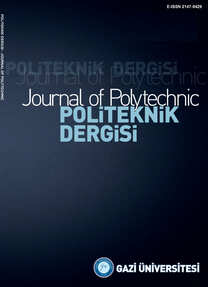Care4HIP: An Embedded System Design for Discerning Hear-Impaired People in Traffic
Hearing-impaired people, , traffic, embedded system, Raspberry Pi 3+.
Care4HIP: An Embedded System Design for Discerning Hear-Impaired People in Traffic
Hearing-impaired people, traffic, embedded system, Raspberry Pi 3+.,
___
- [1] Ogawa T., Uchida Y., Nishita Y., Tange C., Sugiura S. et al., “Hearing-impaired elderly people have smaller social networks: A population-based aging study”, Archives of Gerontology and Geriatrics, 83: 75-80, (2019).
- [2] Girgin M. C., “İşitme Engelli Çocukların Eğitimine Giriş”, Anadolu Üniversitesi, Eskişehir, Türkiye, (2003).
- [3] Zahnert T., “The differential diagnosis of hearing loss”, Dtsch Arztebl Int, 108(25): 433–44, (2011).
- [4] WHO 2019 Report. https://www.who.int/deafness/estimates/en/. Erişim Tarihi: 21.08.2019.
- [5] TUIK, 2002 and 2010 Report. http://www.tuik.gov.tr/PreTablo.do?alt_id=1017. Erişim Tarihi: 01.10.2019.
- [6] Uysal H., “Work psychology of disabled individuals: determination of perceptual and attitudinal differences”, İnsan ve Toplum Bilimleri Araştırmaları Dergisi, 7(4): 2672-2699, (2018).
- [7] Ando K., Serikawa S., Kitazono Y., “Voice recognition and information transmission system for hearing impaired people”, 2017 5th Intl Conf on Applied Computing and Information Technology/4th Intl Conf on Computational Science/Intelligence and Applied Informatics/2nd Intl Conf on Big Data, Cloud Computing, Data Science (ACIT-CSII-BCD); Hamamatsu, Japan, 53-58, (2017).
- [8] Furuhashi M., Nakamura T., Kanoh M., Yamada K., “Haptic communication robot for urgent notification of hearing-impaired people”, 2016 11th ACM/IEEE International Conference on Human-Robot Interaction (HRI), Christchurch, 429-430, (2016).
- [9] Landicho, J. A., Voisee Communicator, “An Android Mobile Application for Hearing-impaired and Blind Communications”, International Journal of Interactive Mobile Technologies (iJIM), 10(4): 26-31, (2016).
- [10] S. Iselin Ertzgaard, N. Kristin, T. Sofie, H. Giske Sindberg, H. Tobias Bang, M. Cosmas, T. Tron Vedul, N. Aslam, Ø. Jon, “Prevalence of hearing impairment among primary school children in the Kilimanjaro region within Tanzania”, Int. J. Pediatr. Otorhinolaryngol. 130:109797, (2020).
- [11] De Oliveira, J. R. M., Lopes, E. S., Alves, A.F., “Speech perception of hearing impaired people using a hearing aid with noise supression algorithms”, Braz. J. Otorhinolaryngol. 76: 14–17, (2010).
- [12] Peddie, K.A., Kelly-Campbell, R.J., “How people with hearing impairment in New Zealand use the Internet to obtain information about their hearing health”, Comput. Human Behav. 73: 141–151, (2017).
- [13] Karmel, A., Sharma, A., Pandya, M., Garg, D., “IoT based Assistive Device for Deaf, Dumb and Blind People”, in: Procedia Comput. Sci., Elsevier B.V., 259–269, (2019).
- [14] Kim, S.Y., Kim, H.-J., Park, E.-K., Joe, J., Sim, S., Choi, H.G., “Severe hearing impairment and risk of depression: A national cohort study”, PLoS One, 12: e0179973, (2017).
- [15] Uygun Y., Teke A. K., Gezgin D. M., “İşitme engelli öğrencilerin türkçe eğitiminde bilgisayar destekli eğitim yazilimi kullaniminin incelenmesi”, Journal of Instructional Technologies & Teacher Education JITTE, 7(1): 36-45, (2018).
- [16] Keser H., Özdemir, O., “İşitme yetersizliği olan öğrencilerin eğitimlerinde bilgisayar destekli kelime öğretim materyali kullanımının incelenmesi”, Ankara Üniversitesi Eğitim Bilimleri Fakültesi Özel Eğitim Dergisi, 19(1): 29-53, (2018).
- [17] Çakır H., Çetin Ş., Baş, A., “İşitme engellilere yönelik dinamik web sayfasının geliştirilmesi”, Bilişim Teknolojileri Dergisi, 6(2): 1-9, (2013).
- [18] Ganesh D. R., Vijaya B. P., “Indoor wireless localization using haversine formula, international advanced research journal in science”, Engineering and Technology, 2(7): 59-63, (2015).
- [19] Sale M., Budhawant A., Bhamare M., Gunjal N., Reshame S., “Intelligent dynamic bus transportation system”, International Journal of Advanced Research in Computer and Communication Engineering, 6(1): 48-49, (2017).
- [20] Dinechin F., Istoan M., “Hardware implementations of fixed-point atan2”, 2015 IEEE 22nd Symposium on Computer Arithmetic, Lyon, 34-41, (2015).
- [21] Gupta V., Kaur K., Kaur S., “Developing small size low-cost software-defined networking switch using raspberry pi”, In: Lobiyal D., Mansotra V., Singh U. (eds) Next-Generation Networks. Singapore: Advances in Intelligent Systems and Computing Springer, 2018.
- [22] Yıldırım M. S., Selvi A. O., Dandil E., “Web based animal tracker system”, 2nd International Symposium on Multidisciplinary Studies and Innovative Technologies (ISMSIT), Ankara, Turkey, pp. 1-5, (2018).
- [23] Örücü, E., Kanbur, A., “Örgütsel-Yönetsel Motivasyon Faktörlerinin Çalışanların Performans ve Verimliliğine Etkilerini İncelemeye Yönelik Ampirik Bir Çalışma: Hizmet ve Endüstri İşletmesi Örneği”, Yönetim ve Ekonomi, 15(1): 85-97, (2008).
- ISSN: 1302-0900
- Yayın Aralığı: 6
- Başlangıç: 1998
- Yayıncı: GAZİ ÜNİVERSİTESİ
Emre KUŞKAPAN, Muhammed Yasin ÇODUR
Bağlayıcı Türünün Atık Çelik Liflerle Üretilen SIFCON Kompozitlerin Mekanik Özeliklerine Etkisi
Serhat ÇELİKTEN, Mehmet CANBAZ
Özgür ÖZTÜRK, Elif AŞIKUZUN, Zeynep Banu HACIOĞLU, Serap SAFRAN
Muhammet Üsame ÖZİÇ, Hakan EKMEKCİ, Seral ÖZŞEN, Mücahid BARSTUĞAN, Aydın YILDOĞAN
3D Baskılı Termoplastik Poliüretan Esnek Dönme Mafsalının Direngenlik Karakterizasyonu
Ufuk Tan BALER, Enis AYKIN, Ali Fethi OKYAR, Nezih TOPALOĞLU
Özlem DAĞLI, Ayşe Güneş TANIR, PH.D., Gökhan KURT
Sena Özlem ARICA, İlhami HORUZ
Using Sulphur Concrete on Defense Buildings
İlker Bekir TOPÇU, Muhammed Emre DANIŞ
Band Gap Engineering of ZnO Nanocrystallites Prepared via Ball-Milling
Telem ŞİMŞEK, Abdullah CEYLAN, Gülçin Şefiye AŞKIN, Şadan ÖZCAN
